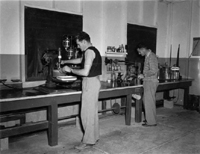|
Gold continued
Corporate underground gold mining continued
The State Prospecting Scheme (1933) was intended to stake unemployed men to encourage prospecting. The State government aimed to remove large numbers of
potentially troublesome men from the State's cities and towns, although given the scope of unemployment they needed little encouragement. The discovery of the huge
Golden Eagle nugget near Coolgardie in 1931 had already prompted a rush of more than a thousand prospectors to the area in which it was found.
In the early 1930s a number of mines, such as the Lake View and Star mines in Kalgoorlie, amalgamated in order to increase efficiencies. The move by some gold
producers to oil-generated electricity away from steam power and the introduction of a new flotation method of treating gold ore also aided a revival in the industry. Mines
reopened in outback areas due to an injection of capital from new companies like Western Mining Corporation. The improvement in the gold industry in a time of Depression saw many men move to the goldfields looking for work.
The presence of a large number of migrants from Italian and Slav backgrounds competing for work with Anglo-Australians increased racial tensions, resulting in the
Kalgoorlie race riots in 1934.
During the Second World War the gold mining industry experienced another big downturn. From 731 mines operating in 1940, there were just 324 in
1943. Lack of timber and firewood, the cost of machinery and labour, and a lack of labour, all contributed to the industry's decline. By 1945 the number of miners employed in the industry had
dropped to a third of the 1939 level.
|
|









